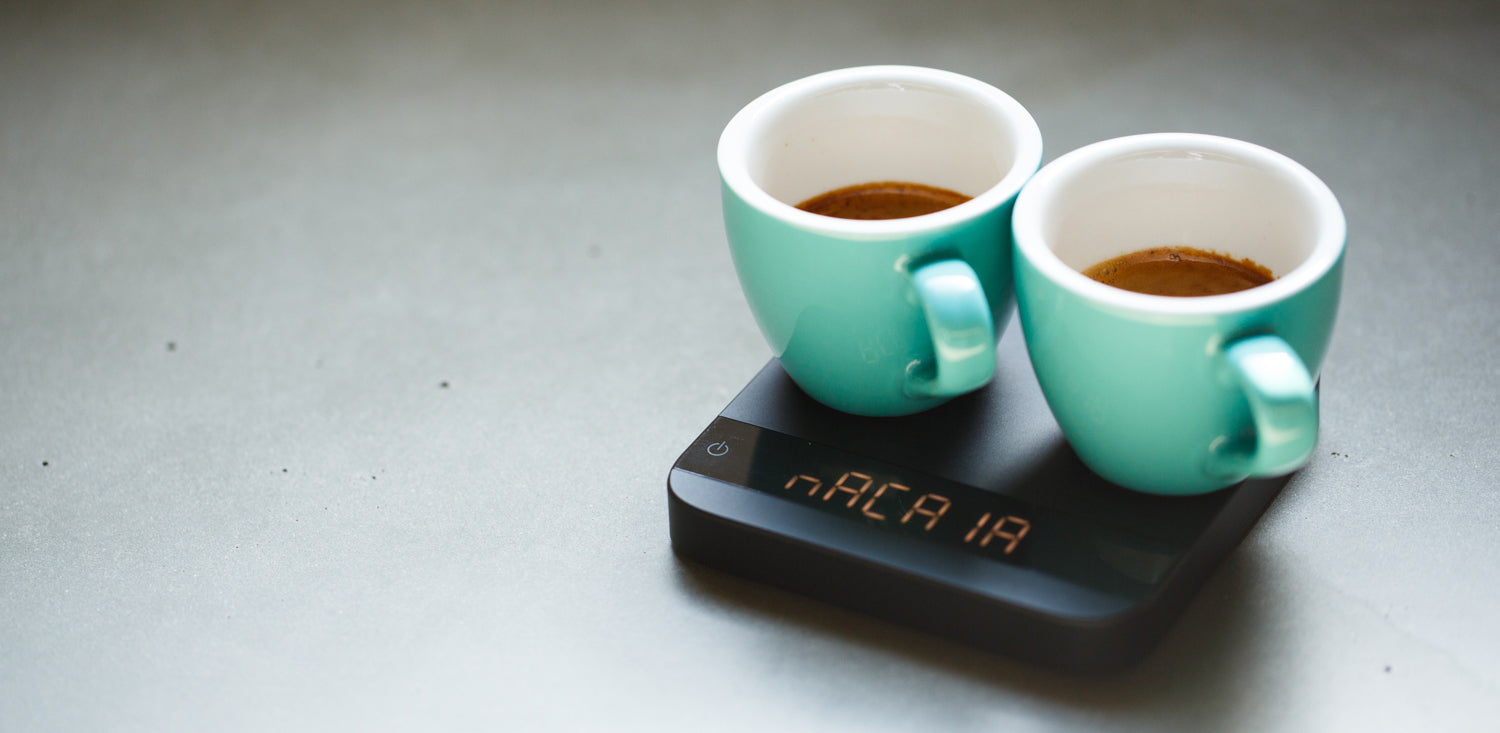With a blog that’s been around as long as this one, we’ve managed to cover a lot of topics. However, given how quickly the world of coffee changes, we figured it was time to revisit one of the most basic (and important) concepts in espresso: the brew ratio.
Simply put, the brew ratio is the relationship between the amount of dry coffee used (the dose) and the amount of coffee extracted (the yield).

This relationship is usually expressed in a dose:yield fashion, so a ratio of 1:2 means that for every gram of dry coffee, we will extract two grams of espresso. Another, less common, way to express a brew ratio is the dose as a percentage of the yield. So, a 1:2 ratio can also be called a 50% ratio. If it’s not obvious already, you’ll need a scale that measures to 0.1g to follow along with this article! There's some fantastic espresso scales out there, but none come even close to the Acaia Lunar, which have a bulk load of cool espresso brewing related features. If however, the eye dropping price of a Lunar is a deterant to purchasing and you want a cheaper non-coffee scale, just make sure it's small enough to fit on your drain tray and if possible is water-resistant.
Ok, so why is the brew ratio so important? You can probably guess that the amount of water used to brew the coffee is going to have a big impact on the strength of the coffee. A shorter shot, or lower ratio, is going to have a more concentrated taste, meaning the mouthfeel will be thick and heavy. On the otherhand, a longer shot or ratio will lead to a more 'watery mouthfeel' as the shot will include more water. The brew ratio is also going to have an impact on the amount of extraction, as well as the nature of the flavours extracted. To see for yourself, just brew up three different coffees: a 1:1 shot, a 1:2 shot and a 1:3 shot. To keep this a bit more ‘scientific’, you’ll want to keep the brew times the same by adjusting the grind setting. So, what do you think? How does the brew ratio affect the balance of flavours? What about the body? Do you have a favourite? Do you want to try a ratio in between two of them?
Now, we didn’t come up with those three ratios off the top of our heads. They correspond roughly to the words Ristretto, Normale and Lungo; with Ristretto being the shortest and Lungo being the longest. The specific usage of these words is (of course) debatable, but we don’t need to get bogged down in that. To us, these terms have become a useful shorthand, whilst the specificity of the brew ratio gives us more understanding, and allows us to learn more about how espresso production really works.
You might have noticed that we haven’t said anything specific about how you should make a coffee. That’s because we want you to discover it for yourself!
There are many ways to brew a good cup of coffee, not just one, and the parameters should be changed to suit the needs of the coffee, equipment, water and the tastes of the consumer. That said, here are some general guidelines. If in doubt, start with a 1:2 ratio. We won’t use the words ‘industry standard’ as we don’t want an inbox full of angry emails, but it is a good, simple, starting point. From feeding hundreds of espressos to students at the academy, we’ve found the majority of them prefer coffee in the 1:1.5 – 1:2.5 range, although this is far from scientific. A really short shot is going to give you a lot of body and intensity. However, with more water you’ll tend to get more clarity of flavour, as well as finding it easier to ‘fully’ extract the coffee. For most people, it’s about finding a balance between these two. You can also ask the barista at your favourite café how they brew their coffee. Most of them will chat forever once you get them started!
For Newbies
If all of this is totally new to you, then here’s what you should do. Firstly, buy yourself a Acaia Lunar Scale like we mentioned earlier:
Yes, they're super super expensive, but if you care enough about your coffee extraction that you've made it to here in an article about 'brew ratio', then you're a pretty serious coffee enthusiast, so a dedicated espresso scale is right up your alley (or perhaps put it on your birthday list). Then go to your machine and brew a coffee the exact way you have always done, except this time weigh your dose and yield, and time the shot from the moment you switch it on. Now write these numbers down. This is your first brew recipe! If you pull a shot of the same coffee, to these parameters, it should taste roughly the same. Now you can start playing around with different ratios and shot times, safe in the knowledge that you can always come back to your original recipe if you need to. The best way to go about it is to change one thing at a time, and then compare the results. We’ve found that by simply paying attention to these numbers and their effects, people's coffee will start getting better.




